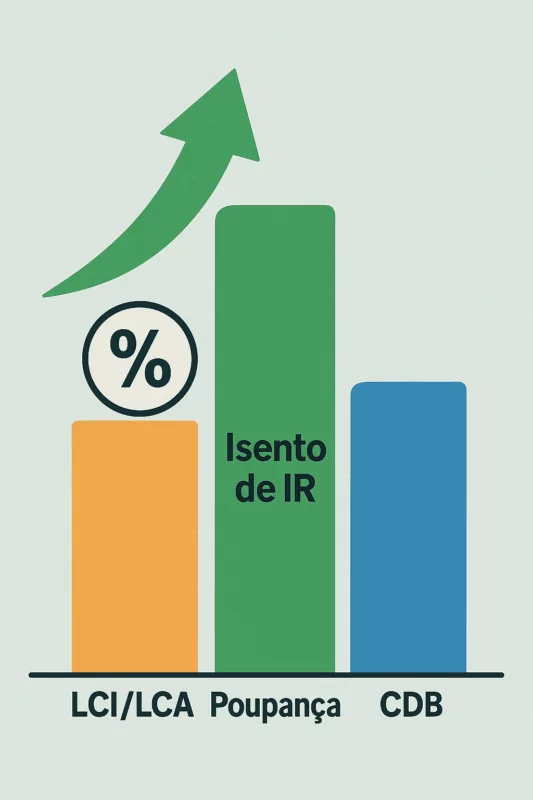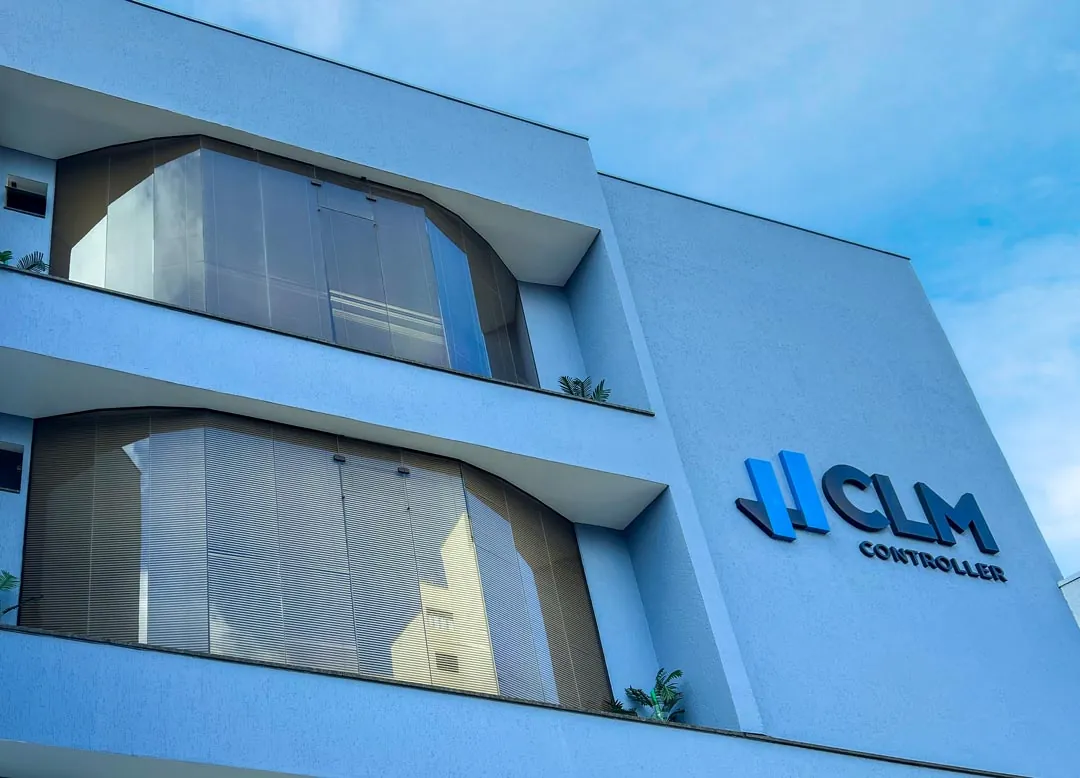In our podcast, Beatriz and Renato break down the recent changes in the taxation of LCI (Real Estate Credit Bills) and LCA (Agribusiness Credit Bills) and what this means in practice for entrepreneurs and investors.
Entrepreneurs of all sizes often look for ways to optimize the use of capital and improve the profitability of temporarily idle resources. It's not uncommon for companies to keep money idle in current accounts or unprofitable investments while they decide on their next steps. Knowledge of investments such as LCI and LCA is essential in this context: these letters of credit can help to maximize the financial gains of the company's cash flowwithout requiring you to take huge risks.
In this article, we'll clearly explain what LCI and LCA are, their pros and cons, compare them to other products (such as CDB and savings accounts) and clear up common doubts - all with a focus on the entrepreneur who wants to make more efficient financial decisions about your company's money.
What are LCI and LCA?
LCI (Real Estate Credit Bill) e LCA (Agribusiness Credit Bill) are fixed income issued by financial institutions to raise funds for the sectors, respectively real estate e agribusiness.
In practice, investing in an LCI or LCA means lending money to the bank that issues the bill - the bank will use these funds to finance real estate loans (in the case of LCI) or agribusiness operations (in the case of LCA). In return, the investor receives interest on the amount investedIt works in much the same way as a CDB. From the investor's point of viewLCI and LCA are practically the same, with only the destination of the funds (backing) that guarantees each piece of paper changing.

A major attraction of LCI/LCA has always been the income tax exemption for individualsThis is a legal requirement to encourage investment in these sectors. In other words, for those who invest as individuals, all the income from these bills is liquidThere is no income tax on the interest received. Thanks to this tax benefit, LCIs and LCAs used to provide higher effective returns than savingsand often competitive or higher than CDBsespecially in longer-term applications.
In addition, just like CDBs and savings accounts, LCI/LCA have the protection of the Credit Guarantee Fund (FGC):
in the event of the issuing bank going bankrupt, the investor is guaranteed to receive back up to R$ 250,000 per financial institution (a limit that takes into account all the investments and accounts of that bank, per CPF). This gives additional security investment, comparable to other conservative banking investments.
How does it work in practice?
Suppose your company (or you, as an individual) invests R$ 100,000 in an LCI that pays interest equivalent to 95% of the CDI per year. If the CDI was around 13% p.a., this LCI would yield around 12.35% p.a. gross.
For an individual, this income of ~12.35% would be net (as the LCI is currently exempt from IR), whereas in a CDB paying 100% of the CDI, the interest would be taxed (ranging from 15% to 22.5% depending on the term, under the current rules).
Even if the nominal rate of the LCI is slightly lower than that of a CDB, the fact that it does not pay tax means that the final gain can exceed that of taxed alternatives. In other words, bills of credit deliver very attractive net returns within traditional fixed income.
Marco Aurélio Director at CLM Controller
Important: it is worth noting that the IR exemption is exclusive to individual investors. If a company (legal entity) invest funds in LCI or LCA, no exemption - taxation will be the same as for a CDB or other ordinary fixed-income investment, following the applicable rates. For this reason, many entrepreneurs choose to invest in LCI/LCA for individuals (PF), when possible, in order to take advantage of the tax benefit, or they compare these bills to other products available to the public. legal entity investments. Later in the FAQ, we'll go into more detail about who can invest and how this difference between PF and PJ works.
Advantages and disadvantages of LCI/LCA
Like any financial product, LCIs and LCAs have benefits and limitations. Below, we summarize the main positive and negative points of these investments - already comparing some aspects with competing investments, such as CDBs and traditional savings.
Advantages of LCI/LCA:
-
Income tax exemption (for individuals): All income is net, with no IR charged, which increases net profitability in relation to taxed investments. This tax incentive has been an important differentiator (although there is a proposal for a tax change, explained below, the rate would still be much lower than for other products).
-
FGC protection: Just like CDBs and savings accounts, bills of credit have the following features FGC guarantee of up to R$ 250,000 per CPF and per financial institution, offering security against credit risk in investments within this limit. This means that, for most investors, the risk of loss due to bank failure is minimized - something that alternative exempt investments, such as CRIs/CRAs or incentivized debentures, do not offer.
-
Good return on fixed income: LCIs and LCAs generally have attractive ratesThese are often linked to a high percentage of the CDI or to inflation + interest indexes. In practice, can yield more than savings (which today yields around 6% p.a.) and, thanks to the IR exemption, can match or exceed CDBs of the same term in terms of net return. Medium-sized banks usually offer LCI/LCA with a return of close to or greater than 100% of CDIThis is precisely to attract investors interested in this tax break.
Disadvantages of LCI/LCA:
Low liquidity and grace periods:
Unlike savings (immediate withdrawal) or some CDBs with daily liquidity, you can't redeem LCI/LCA at any time. There is a mandatory minimum waiting period - recently amended by the National Monetary Council - which is now 12 months for LCI and 9 months for LCA.
This means that, after applying, you you won't have access to the money for at least a few monthseven in emergency cases. Many titles only allow redemption on final maturityThis is usually between 1 and 3 years from the date of application. In other words, not suitable for short-term needs - if your company is likely to need the funds soon, an LCI/LCA could be problematic.
High minimum values:
In several cases, a minimum investment is required to invest in LCI/LCA, especially the options with the best yields. Often, the most profitable are only available for contributions of R$ 30,000, R$ 50,000 or more.
. Some brokers offer LCI/LCA for smaller amounts, but generally at less attractive rates. This can be a barrier for small businesses or novice investors - unlike savings (which have no minimum) or some affordable CDBs with R$100 or R$1000.
Time-limited options:
Unlike government bonds or some CDBs that offer varying terms (very short or very long), LCI/LCA usually have intermediate deadlines (months to a few years). This can be a double disadvantage: not always useful for very short-term objectives (due to the shortage and low liquidity) and, at the same time, may not meet very long-term objectivesIt's not common to find bills with maturities of more than 3-4 years.
Conservative investors who want to plan beyond this horizon may need to reinvest the funds in new investments at the end of the LCI/LCA, taking on reinvestment risk (the uncertainty about what rates will be available in the future).
Below, to make the comparison clearer, we bring you a comparative table between LCI, LCA and two well-known fixed-income alternatives - the CDB and savings accounts. This comparison summarizes the main characteristics, advantages and disadvantages of each option for individual investors.
| Features | LCI (Real Estate Credit Bill) | LCA (Agribusiness Credit Bill) | CDB (Bank Deposit Certificate) | Savings Account (Caderneta de Poupança) |
|---|---|---|---|---|
| Issuer / Purpose | Bank (or financial institution) raises funds to finance real estate loans. | Bank raises funds to finance agribusiness credit. | The bank raises funds for its general operations (loans, working capital, etc.). | Bank receives deposits to make up its funding sources (housing, rural and others). |
| Typical Profitability | Post-fixed (% of CDI) or pre-fixed/inflation; generally high due to IR exemption (e.g. ~90-100% of net CDI). | Similar to LCI (equivalent rates, only the sector financed changes). | Post-fixed (% of CDI), pre-fixed or inflation-linked; can reach or exceed 100% of gross CDI, depending on the issuing bank and term. | Government-regulated rate: ~6% p.a. currently (0.5% p.m. + TR when Selic >8.5% p.a.), varying according to the basic interest rate. |
| Liquidity | aixa: minimum grace period of 12 months; many LCIs only allow redemption on maturity (1-3 years). Some offer redemption after the grace period, but do not have immediate daily liquidity. | Low: minimum grace period of 9 months; other conditions equivalent to those of the LCI (can be redeemed only at maturity, typical 1-3 years). | Variable: there are CDBs with daily liquidity (redemption at any time after 1 day) and CDBs with liquidity only at maturity (term can be from 30 days to several years). The investor chooses according to the bank's offer. | High: practically immediate liquidity. You can withdraw at any time. Note: interest on savings accounts is credited on each monthly "anniversary" of the investment - withdrawals before the anniversary date may lose the return from the last period. |
| Income Tax (PF) | Income tax exempt for individuals (until the end of 2025). From 2026 onwards, proposed flat-rate taxation of 5% at source. | Exempt from IR (same rule as LCI for individuals until 2025). Taxation of 5% expected from 2026, if the law is passed. | Taxed (for individuals) according to a regressive table: 22.5% (up to 180 days), 20% (181-360 days), 17.5% (361-720 days) and 15% (over 720 days). Proposal for a single rate of 17.5% from 2026 for any term. | Exempt from personal income tax (no changes expected). |
| FGC coverage | Yes - FGC up to R$ 250,000 per CPF, per institution (aggregate limit R$ 1 million every 4 years). | Yes - FGC up to R$ 250,000, same rules as LCI. | Yes - FGC up to R$ 250,000 per CPF, per institution. | Yes - savings deposits have FGC up to R$ 250,000 (savings are considered in the same limit as the issuing bank, along with CDB/current account, etc.). |
| Advantages | - Higher net returns (excluding income tax), especially over medium terms. - FGC security and incentives for the real estate sector. - Diversification in the fixed-income portfolio, with fixed-rate options, CDI% or inflation + interest. | - High net return, exempt from IR (PF), promoting agribusiness. - FGC guarantee, low risk for insured amounts. - Prefixed, post (CDI) or inflation rate options, similar to the LCI. | - Variety of terms and liquidity: choose between a daily return or a fixed term depending on the company's cash requirements. - Competitive rates: some CDBs from medium-sized banks offer >100% of the CDI (albeit gross) to attract investors. - FGC included: security up to 250k per bank. | - Ease of use and total liquidity: ideal for immediate reserves, without worrying about the term. - No income tax and no fees: all earnings are net, with no contributions or fees. - Simplicity: any amount, no bureaucracy - popular and easy to understand. |
| Disadvantages | - Low liquidity: not suitable for short-term needs (grace period ≥12 months). - Minimum investment can be high (many LCIs require >R$ 5-30 thousand). - Limited term: rarely >3 years, requiring post-maturity reinvestment. | - Restricted liquidity: grace period ≥9 months; similar to LCI in this respect. - Smaller offer: less common than LCI in some banks and may limit options. - Minimum investment and term follow LCI conditions (may require larger capital and a 1-3 year horizon). | - IR taxation: lowers net yield - needs a higher gross rate to compete with exempt LCI/LCA. - Short term X return: CDBs with daily liquidity generally pay a lower percentage of the CDI; to get better rates, you generally have to accept longer terms (and interest market risk). | - Low profitability: the savings account rule makes it unattractive in high interest rate scenarios - it often earns less than inflation, eroding the purchasing power of the money. - Monthly anniversary: if you need to redeem days before the anniversary, you lose that month's interest, which can further reduce the gain. |
Note: In the above comparison, we consider the perspective of individual investor for LCI, LCA, CDB and savings accounts, as the rules on profitability and taxation differ especially in this case.
Legal entities investing in CDBs basically follow the same conditions as those listed above (IR rates the same as for individuals). On the other hand, companies investing in LCI/LCA are not exempt from income taxpaying the same taxes as an equivalent CDB - so for investments from the company's cash (PJ)As a result, bills of credit lose much of their advantage and are generally less sought after by corporate clients than by individual investors.
Frequently Asked Questions (FAQ) about LCI and LCA
Below, we provide objective answers to some of the following questions common questions from entrepreneurs about these investments:
Is LCI liquid?
In general, do not have daily liquidity. It means that you you can't redeem the LCI at any timeunlike an investment in savings or some funds. By regulation, there is a minimum grace period (currently 12 months for LCI and 9 months for LCA). Some institutions offer LCI/LCA with the possibility of redemption after the grace period - for example, after the minimum 12 months, the letter could have daily liquidity from then on. However, many lyrics they only release the money when it's dueThis is usually 1, 2 or even 3 years after the application. In short, LCI has low liquidity before the due date.
If you are likely to need the funds in the short term, it is not suitable. There is also the option of sell the LCI/LCA on the secondary market before maturity, but it's not always easy to find buyers - it can take time to find an interested party or demand a discount on the price, so it's not a guarantee of liquidity.
Can an entrepreneur invest as an individual?
Yes. If you're an entrepreneur, there's nothing to stop you invest your money as an individual (PF) in LCI, LCA or any other financial product, as long as you have the funds in your name. All you need is an account with a broker or bank and an application linked to your CPF.
Many entrepreneurs opt for withdraw pro-laboredividends or profits of the company and then invest those resources as PFIt is also possible to take advantage of tax benefits available only to individuals (such as the IR exemption on LCI/LCA, until 2025).
This is a valid strategy for making "personal" money work. The funds that remain in the company's CNPJ can be invested as legal entity investments (which have other options and rules). However, there is no legal restriction preventing entrepreneurs, as individuals, from investing on their own in LCI, LCA or other products - the process and conditions will be the same as for any individual investor.
Can legal entities (companies) also invest in LCI/LCA?
You can, but with reservations. Legal entities can invest in LCI and LCA, however without the benefit of IR exemption. For companies, the income from these bills is taxed normally (IR according to the general rules for financial investments).
In practice, a PJ LCI ends up being equivalent to a CDB in terms of taxation - you will pay tax on interest, which eliminates the advantage that so attracts PF investors. In addition, some institutions may not even offer LCI/LCA to PJ clients, as demand is usually low.
Companies generally prefer CDBs, funds or Treasury Direct to manage cash, as they offer more liquidity flexibility and, in the case of CDBs, the same tax conditions. Therefore, the bill of credit is not used so much by companiesUnless the rate offered is very competitive to the point of compensation. In a nutshell: your company can invest in LCI/LCA, but assess whether it makes sense - without tax exemption, perhaps a CDB or DI fund with daily liquidity is more suitable for short-term cash investments, for example.
Is it still worth investing in LCI/LCA with the new 5% tax?
Probably yes, it's still worth italthough it depends on the actual rates offered. The government has proposed that, from 2026, LCI and LCA yields will pay 5% IR at source. This reduces the advantage a little, but it is a tax rate quite low compared to other investments.
For example, a CDB currently pays 15% in income tax after two years, and under the proposal it would pay a fixed 17.5%; the LCI/LCA would only pay 5%. In practical terms, imagine an LCI with a gross yield of 10% per year: without tax (until 2025), the net gain is 10%. With 5% of IR, the net gain would be ~9.5%. Meanwhile, a CDB with the same gross yield of 10% today would net only 8.5% (if it were taxed at 15%) or 8.25% (if it were taxed at 17.5%). In other words, even with 5% tax, LCI/LCA would still deliver more net return than many comparable CDBsat the same gross rate.
What's more, the 5% rate is fixed - much lower than the 15%-22.5% that fixed-income investments pay today. Therefore, it's still worth it consider LCI/LCA for those looking to optimize gains, especially for terms of 1 year or more. Of course, with the change, banks may adjust the rates offered (they may reduce the percentage of the CDI paid a little, for example), but the relative tax advantage remains. So, for individual investors, LCI/LCA should continue to be an attractive fixed income option, albeit slightly less advantageous than in the 100% exempt era.
What will change with the 5% tax proposed for 2026?
In short, what changes is that LCI and LCA would no longer be 100% exempt and would now have a small discount of tax on interest from 2026. The Provisional Measure presented by the government in 2025 establishes Withholding tax on 5% on income from investments that are currently exempt. This includes LCI, LCA and other "incentivized" securities such as CRI, CRA and incentivized debentures.
According to Ministry of Financethe idea is correcting distortionsFor example: currently those who invest in these securities pay 0% in income tax, while other fixed-income products pay up to 15% or 17.5% in income tax, so there would be a partial equalization. In practice, 5% is a very low rate - bonds are still "incentivized"In the minister's words, only a little less than before. For the investor, this means that the net return on new LCI/LCA investments will fall slightlybut not dramatically. Investments already made before 2026 will possibly maintain the original conditions until maturity (this definition still depends on regulation; it was unclear whether the tax would apply to current stock or only new investments from 2026 onwards).
Comparatively, there is also a proposed change for other assets: CDBs, Treasury bonds and debentures would now have unified taxation of 17.5% (instead of the current regressive table). So, from 2026, we would have a scenario in which: LCI/LCA paying 5% IR vs. CDB paying 17.5% IR for any term. This maintains a significant difference in favor of bills of credit. In short, the change reduces the advantagebut does not eliminate - LCI and LCA will continue to be attractive for individuals, especially when compared to equivalent investments that pay full tax.
With taxation, would it be better to return to savings?
Savings accounts are unlikely to become more advantageous. Savings accounts remains exempt from IRbut its income is very low compared to LCI/LCA or CDB. Currently, even before savings already yield much less than the CDI (around 6% p.a.), while a typical LCI yields close to 12% p.a. gross (which is net for individuals). If the LCI yields ~11.4% net (taking into account 5% tax on 12% gross, for example), it will still be a good investment. way above of the 6% of savings.
Therefore 5% taxation does not make savings more attractive than LCI/LCA in most scenarios. Savings could only be competitive if basic interest rates fell dramatically (as they are 70% of the Selic when the Selic is <8.5% p.a., but that's a specific scenario). Generally speaking, LCI/LCA continue to beat savings in profitabilityeven considering the new tax.
Taxation of 5% from 2026: what entrepreneurs need to know

As detailed above, the tax reform investment forecasts major changes from January 2026 (subject to congressional approval). To recap the key points of the fiscal impact for fixed-income investments:
End of the total IR exemption for LCI and LCA:
currently exempt for individuals, will now have IR of 5% at source on income, if the measure is confirmed. Nevertheless, this rate is much lower than for other investments (this amounts to an even more favorable treatment than normal taxation of 15% or more).
Unification of the IR rate on ordinary fixed income:
Investments such as CDBs, Tesouro Direto and debentures (which currently follow the 22.5%-15% regressive table) would all be subject to the 17.5% fixed IR on interest, regardless of the term. This simplifies the rule and, for short terms, even reduces the tax (from 22.5% to 17.5%), but for long terms it increases it a little (from 15% to 17.5%). For comparison purposes, we can consider this 17.5% as the new "full rate" for standard fixed income.
Maintenance of incentive (albeit minor):
As a result, LCI/LCA would continue to have a tax advantage compared to other products - paying 5% of IR instead of 17.5% means a tax saving of 12.5 percentage points. In the government's view, this reduces distortions and helps to balance the market, but from the investor's perspective, bills of credit continue to offer a comparatively higher net return.
Impact on business strategies:
If you, as an entrepreneur, invest personally in LCI/LCA, you should consider that the future net return will be slightly lower, but still attractive. Maybe it's worth it, for example, bringing applications forward to 2025 under the current rules (0% IR) if you find good rates, locking in this exempt yield until maturity.
On the other hand, if you keep company resources invested (via CNPJ), the change makes some applications of very short term more efficient - for example, surplus cash invested in a CDB with daily liquidity will be taxed at 17.5% (instead of 22.5% if redeemed before 6 months, as it is today). But the main thing remains the same: companies didn't have an exemption on LCI/LCA before, and they still won't - so for the PJ cashierThe comparison between LCI/LCA vs. CDB still depends only on the gross rates offered.
Many companies may prefer CDBs with daily liquidity or DI funds for emergency reserves, and LCI/LCA (even with 5% of IR) for 1-2 year objectives, as long as the funds can be immobilized during this period. In any case, it is important to follow the progress of this law and adjust the company's financial strategy according to the final definitions of taxation.
In short, the taxation of 5% on LCI and LCA, scheduled for 2026, does not make these products unviablebut requires attention from investors. Entrepreneurs and financial managers should recalculate the return projections taking the tax into account, compare them with the new rates for other investments and, if necessary, adjust them accordingly, rebalance the business or personal investment portfolio to continue maximizing gains within the new regulatory scenario.
Conclusion - How CLM Controller can help your company
Making the right financial decisions - whether to invest the company money with tax efficiency, either for planning your personal investments as an entrepreneur - can make a big difference to your results. A
A CLM Controller is the entrepreneur's partner in this process. With more than 40 years' experience serving companies of all sizes, we offer the following services accounting, fiscal, tax, financial and labor consultancy high level.
Our team acts in an advisory capacity, helping to better structuring of financial management of the business and the allocate resources with tax intelligencealways with an eye on controlling and optimizing results. If you want to understand in detail how taxes affect your corporate and personal investmentssearch for the best way to invest your company's idle capital or simply have more security in your financial decisions, count on the support of CLM Controller.
We are ready to help you build a solid financial strategy that combines profitability and tax complianceboosting the sustainable growth of your business.
Get in touch with CLM Controller and discover how our accounting and consulting services can add value to your company's financial management, ensuring peace of mind and efficiency so you can focus on what matters most: the success of your business.









